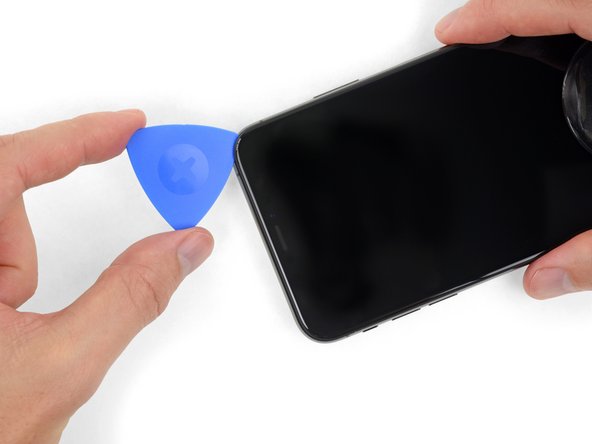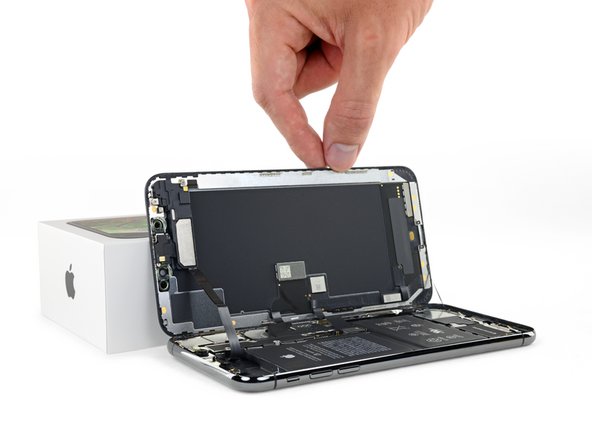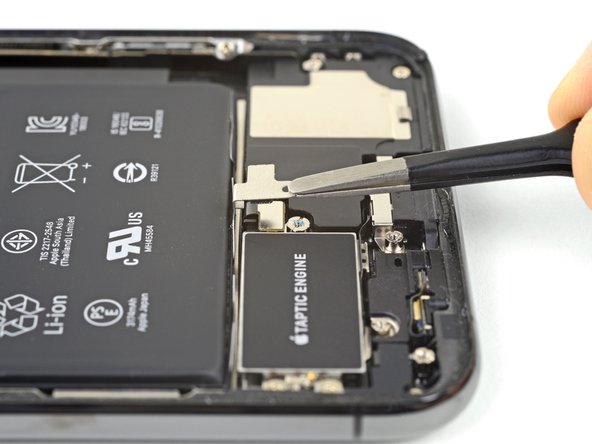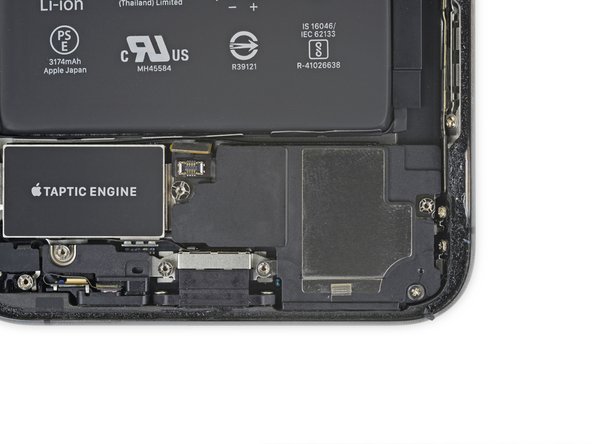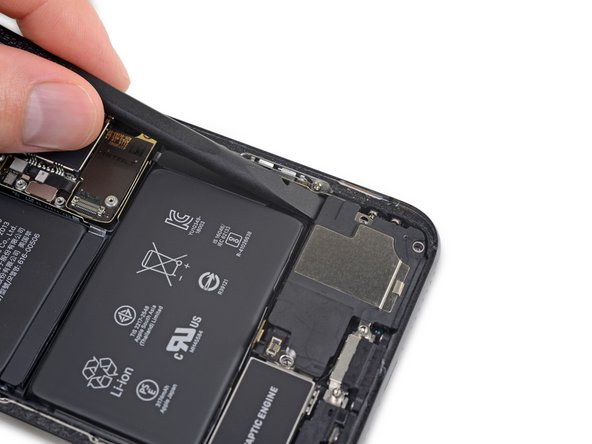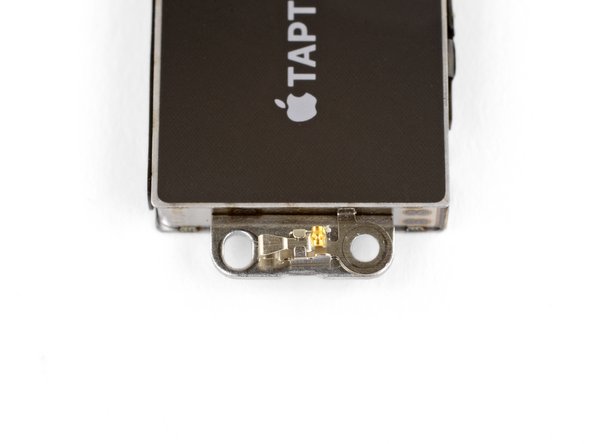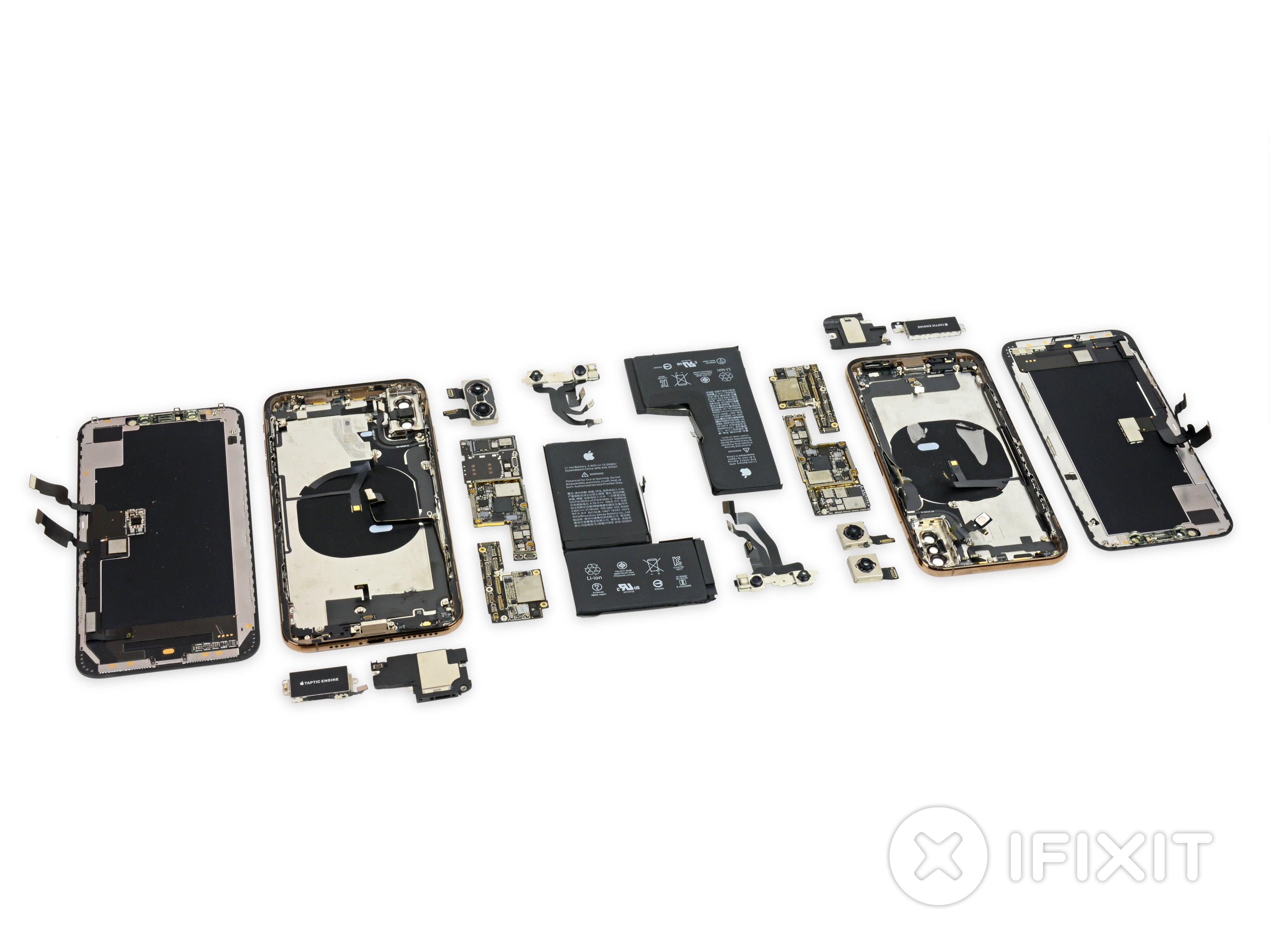iPhone XS Max Taptic Engine Replacement
Duration: 45 minutes
Steps: 40 Steps
The Taptic Engine is what gives your iPhone its delightful vibrations and haptic feedback. Ready to dive in? Follow this guide to safely remove or swap out the Taptic Engine in your iPhone XS Max. We’ll walk you through the process of fully detaching the display assembly—this is just to make sure those delicate display cables don’t get any accidental love taps while you work. If you’re feeling confident and think you can handle the Taptic Engine swap without risking those cables, feel free to skip the steps for unplugging them. Let’s get to it!
Step 1
Before diving in, make sure to drain your iPhone battery to under 25%. A fully charged lithium-ion battery can be a bit dramatic and may catch fire or even explode if it gets a little too much attention. Safety first, friends!
- First things first, make sure your iPhone is powered down before diving in.
- Next up, grab your trusty screwdriver and remove those two 6.9 mm-long pentalobe screws at the bottom edge of your iPhone.
- Just a heads up! When you open up your iPhone's display, you're breaking the waterproof seals. So, have some replacement seals ready before moving on, or be extra cautious to keep your iPhone away from any liquid if you're planning to put it back together without swapping the seals.
Step 2
Pushing the opening pick in too deep can mess things up inside your device. To avoid that, mark your pick at the right spot before you start.
Feel free to add marks on other corners of the pick with different measurements for extra control.
Another neat trick is to tape a coin onto the pick about 3 mm from the tip to keep your depth in check.
- Take a measuring tape and mark a spot 3 mm from the tip of the opening pick with a permanent marker. You've got this!
Step 3
Pop on some safety glasses—your eyes deserve protection from any surprise glass bits that might try to make a break for it.
Got a cracked screen on your iPhone? No worries—keep things safe and avoid any more breakage by sticking some tape over the glass while you work. It's a simple way to keep things under control!
If you hit a snag and need a little extra help, you can always superglue the suction cup to the screen for a stronger grip.
- Pop on some clear packing tape over your iPhone's screen, overlapping the strips until the whole face is snugly covered. It's like giving your phone a little protective blanket!
- If the suction cup seems to be a little shy and won't stick, grab a sturdy piece of tape (duct tape works wonders) and fold it into a handy handle. You can use that to gently lift the screen instead!
Step 4
The next three steps show you how to use the Anti-Clamp, our nifty little tool designed to make the opening process smoother. If you're not using the Anti-Clamp, no worries! Just skip ahead three steps to follow the alternative method.
Need a bit more guidance on how to use the Anti-Clamp? Check out the full instructions right here in this handy guide.
If you find your iPhone a bit too slick for the Anti-Clamp to grab onto, just add a bit of tape to create a better grip. Easy fix!
- Give the blue handle a little pull to release the Anti-Clamp's arms and get them ready for action.
- Gently slide the arms over one of the edges of your iPhone—either the left or the right will do.
- Place the suction cups right near the bottom edge of your iPhone—one on the front, one on the back.
- Squeeze the cups together to create a strong hold and make sure they’re stuck in the right spot.
Step 5
- Slide that blue handle forward to lock those arms in place—like you're giving them a power hug.
- Give the handle a full spin clockwise (yep, 360 degrees) or keep turning until you see those cups start to stretch out.
- Keep an eye on the suction cups; they should be lining up together like besties. If they start wandering apart, loosen them up a bit and get those arms back in sync.
Step 6
Turn no more than a quarter turn at a time, then take a breather for a minute. Let the Anti-Clamp and a little patience do the heavy lifting!
A hair dryer, heat gun, or hot plate can help here—just don’t go wild with the heat, unless you want your display and battery to throw a tantrum.
If the Anti-Clamp isn’t giving you enough space, hit the area with a bit more heat and give the handle a quarter turn. Easy does it!
- Warm up that iOpener and slide it through the arms of the Anti-Clamp like a pro.
- Bend the iOpener so it rests comfortably on the bottom edge of your iPhone.
- Hang tight for a minute to let that adhesive loosen up and create a little opening.
- Gently slide an opening pick into the gap between the screen and the plastic bezel, avoiding the screen itself.
- Feel free to skip the next three steps; you've got this!
Tools Used
Step 7
Gently warm up the lower edge of your iPhone to loosen up the adhesive holding the display in place. This will make the process of opening it up a lot smoother and less frustrating.
- Grab a hairdryer or heat gun, or whip up an iOpener, and give the bottom edge of your iPhone some warm love for about a minute. This will help loosen that stubborn adhesive hiding underneath. You're doing great!
Tools Used
Step 8
- Using a single suction handle? No problem! Stick it to the bottom edge of your phone, but steer clear of that curved glass area. You've got this!
Tools Used
Step 9
The adhesive holding the display in place is pretty tough; getting that first gap open takes a bit of muscle. If you're struggling, try adding a little extra heat, and gently rock the screen up and down. This will weaken the adhesive and give you just enough room to slide in your tool and keep going. Patience is key!
- Give that suction cup a solid upward pull—steady does it—until you spot a tiny gap between the front panel and the back case.
- Slide an opening pick into the gap, aiming under the screen and that plastic bezel (not the screen itself—let’s keep things smooth).
Step 10
Keep your pick insertion under 3 mm to avoid poking any sensitive bits inside.
- Take your trusty opening pick and glide it around the lower left corner, then up along the left side of your iPhone, slicing through that stubborn adhesive that’s keeping the display locked down. Nice and steady wins the day!
Step 11
Heads up! There are some fragile cables hanging out along the right edge of your iPhone. Avoid sliding your pick in there to keep everything safe and sound.
Step 12
Keep your pick insertion shallow—no deeper than 3 mm—to avoid messing up those delicate display cables.
- Slide your pick back in at the bottom edge of the iPhone, then glide it up along the right side to keep loosening that stubborn adhesive.
Step 13
Be gentle with the clips—they’re delicate and can snap if you get too eager. Take your time and stay cool.
Keep your pick insertion under 3 mm to avoid messing with the front panel sensor array.
The upper part of the screen is held in place with a combination of adhesive and clips, so be ready for a little teamwork between them!
- Gently glide that opening pick around the top corner of the display while giving it a little tug or wiggle down toward the Lightning port. You're doing great!
- Now, slide that pick over to the opposite corner and slice through any stubborn adhesive still holding on to the display. You've got this!
Step 14
- Give the little nub on the suction cup a gentle tug to pop it off the front panel. You've got this!
Step 15
Hold off on fully lifting the display—there are still some delicate ribbon cables hanging out with the logic board, and they’d really prefer not to be ripped away just yet!
- Pop open your iPhone by swinging the screen up from the left—think book cover vibes.
- Prop that display up against something sturdy to keep it out of your way while you work your magic.
- When you're putting things back together, set the display in place, line up the clips at the top, and gently press the top edge down first. Once the top clicks in, snap the rest into place. If it’s being stubborn, check if any of those little clips around the edge are bent out of shape.
Step 16
As you go through this repair, keep an eye on every screw—each one has its own spot, and mixing them up can cause trouble for your iPhone.
- Take out the four Y000 screws holding down the logic board cover bracket. Here’s the lineup:
- Two screws at 1.1 mm
- One screw at 1.5 mm
- One screw at 3.7 mm
Step 17
The bracket might have a slight cling to it. Give it a gentle lift—steady hands win this round!
- Take off the bracket.
- As you put things back together, this is a great moment to power on your iPhone and make sure everything’s working perfectly before snapping the display back in place. Don’t forget to fully power it down again before moving on!
Step 18
Be gentle with the black silicone seal that hugs the board connections. This little hero helps keep water and dust at bay, so let's give it the love it deserves!
- Gently use a spudger or your clean fingernail to lift the battery connector out of its socket on the logic board.
- Carefully bend the connector a little away from the logic board so it doesn’t accidentally touch the socket and power up the phone while you’re working.
Tools Used
Step 19
- Let's get those three Y000 screws out to free up the display connector bracket:
- Two screws measuring 1.5 mm
- One screw measuring 1.1 mm
Step 20
- Time to take off the bracket! Grab your tools and carefully remove it.
Step 21
- Gently use the tip of a spudger or your fingernail to carefully unplug the front panel sensor assembly connector.
Tools Used
Step 22
- Grab a spudger or your trusty fingernail and gently disconnect that OLED panel cable connector. You've got this!
- When it's time to reattach those connectors, take a moment to align them carefully. Press down on one side until you hear that satisfying click, then do the same on the other side. Remember, no pressing down in the middle! If things get misaligned, those little pins might bend and nobody wants that. Keep it smooth and steady!
Tools Used
Step 23
- Gently pop up the digitizer cable connector using a spudger or your fingernail—think of it as giving your device a little high five.
- If your screen decides to ignore your touch after the repair, unplug the battery, reseat the connector until you feel that satisfying click, and double-check the socket for any dust or sneaky debris trying to crash the party.
Tools Used
Step 24
The front panel sensor assembly flex cable is gently stuck in place, so be careful as you work with it.
- Gently pull the cable upwards until the adhesive lets go.
Step 25
- Lift off the display assembly like you’re opening a book to a new chapter.
- If you’re feeling fancy and want to refresh that waterproof seal, this is the perfect moment to work some adhesive magic around the edges before putting things back together.
Step 26
- Take out the five 1.4 mm tri-point Y000 screws that are holding down the bracket under the Taptic Engine and main speaker. Let’s get those little guys out of the way!
Step 27
The bracket is gently stuck on, so a little patience (and maybe a gentle nudge) will help it come loose.
- Gently lift the bracket to release it, but take care not to bend it in the process.
- If needed, apply a bit of heat with a hair dryer or heat gun to loosen the adhesive. (Avoid using an iOpener on the bracket—it could bend the spring contacts on top.)
Tools Used
Step 28
- Let's get that speaker connector cover off! Start by removing the 1.3 mm tri-point Y000 screw that’s holding it in place. You've got this!
Step 29
Handle that battery like it’s a delicate balloon—you don’t want to pop it! Be extra cautious with your tools to avoid any accidental punctures.
- Gently slide the speaker connector cover toward the battery, then lift it up to pop it free and remove it.
Step 30
- Gently use the spudger's tip to lift and disconnect that speaker connector. You're doing great!
Tools Used
Step 31
If you’re reaching for a small flathead screwdriver, just go slow and steady—these little guys love to slip, and your nearby components would rather not get poked.
To tackle those pesky standoff screws, grab yourself an iPhone Standoff bit and a driver handle. It's the perfect combo to make your repair journey smoother!
- Let's kick things off by loosening the three screws holding the speaker in place. Here's what you'll need:
- A 2.7 mm Phillips screw – it's small, but mighty.
- A 2.9 mm standoff screw – just a tad bit longer, so keep track of it.
- A 3.1 mm standoff screw – the final piece of the puzzle.
Step 32
When you're carefully lifting the speaker, keep an eye out for that sneaky speaker flex cable you just detached. If it feels a bit cramped, just give it a gentle nudge towards the battery to create some breathing room for the speaker to pop out smoothly.
- Slide a spudger under the top edge of the speaker, right by the edge of your iPhone's case.
- Carefully pry up and lift the speaker's top edge just a bit — no need to rush it!
- When putting the speaker back, double-check that the flex cable is sitting pretty and isn’t caught underneath.
Tools Used
Step 33
If needed, warm things up a bit to loosen that adhesive. It'll help you peel off the bumper strip like a pro!
- As you gently pry up the speaker, grab your tweezers and carefully peel the plastic bumper strip off the speaker’s top edge like a pro.
Tools Used
Step 34
- Grab the speaker by its edges and give it a little wiggle from side to side to break that adhesive grip it has on the bottom edge of your iPhone.
- Gently pull the speaker away from the bottom edge until you hear that satisfying pop of the adhesive gasket letting go.
Step 35
- Carefully take out the speaker.
- Heads up: the speaker’s adhesive gasket is a one-time deal. Use tweezers to peel off any leftover sticky bits.
- To keep water and dust out, swap in a fresh adhesive gasket when putting things back together. Clean the area first with some isopropyl alcohol and a lint-free cloth or coffee filter so the new gasket sticks like a champ. Pop the new gasket onto the speaker, then reinstall it.
Tools Used
Step 36
- Grab your spudger and gently pop the Taptic Engine flex cable up from its socket. A little wiggle, a little lift—easy does it!
Tools Used
Step 37
- Unscrew those two 1.9 mm Phillips screws that are holding the Taptic Engine in place. You've got this!
Step 38
- Grab the plastic bumper strip and gently lift it up and over the speaker connector—easy does it!
Step 39
- Carefully take out the Taptic Engine assembly.
- Heads up! The contact clip on the left side of the Taptic Engine is a bit sneaky and might pop off. Make sure it’s snapped in place just like the picture before you put the Taptic Engine back into the iPhone.
Step 40
- Before you dive into installation mode, take a moment to match your shiny new replacement part with the original—sometimes you’ll need to swap over a few components or peel off some sticky stuff from the new part.
- Time to put it all back together! Just retrace your steps from above, and you’ll be golden.
- Got some e-waste? Don't just toss it! Find an R2 or e-Stewards certified recycler to give it a proper send-off.
- Things didn’t go quite as you envisioned? No worries! Swing by our Answers community for some troubleshooting tips and tricks.

































